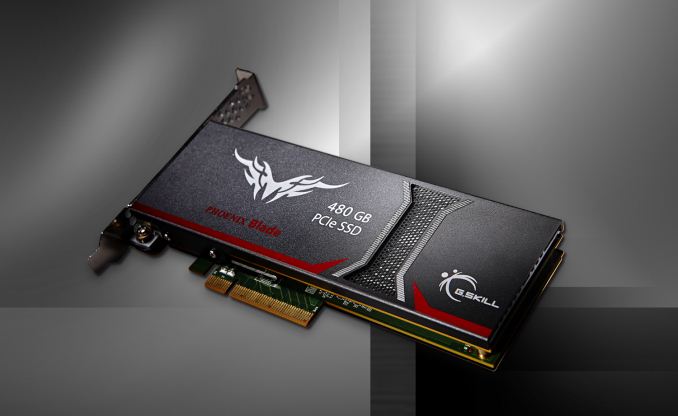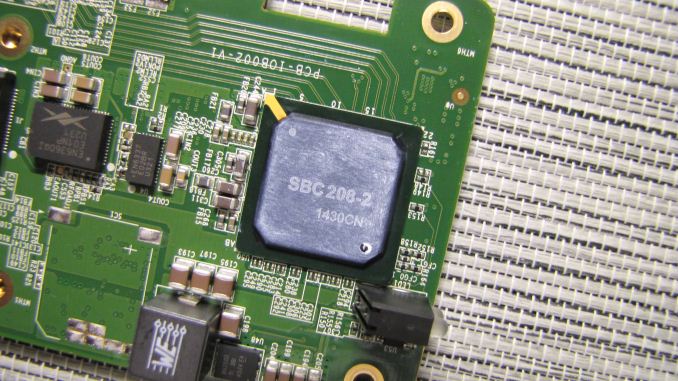G.Skill Phoenix Blade (480GB) PCIe SSD Review
by Kristian Vättö on December 12, 2014 9:02 AM EST
G.Skill hasn't been a very visible SSD OEM lately. Like many DRAM module companies, G.Skill entered the market early around 2009 when the market was very immature and profits were high, but lately the company has more or less been on a hiatus from the market. Even though G.Skill has had an SF-2281 based Phoenix III in the lineup for quite some time, it never really did anything to push the product and a Google search yields zero reviews for that drive (at least from any major tech review outlet).
However, back at Computex this year G.Skill showcased a prototype of its next generation SSD: the Phoenix Blade. Unlike most SSDs on the market, the Phoenix Blade utilizes a PCIe 2.0 x8 interface, but unfortunately it is not the native PCIe drive many of you have been waiting for. It is driven by four SandForce SF-2282 controllers in a RAID 0 configuration. It makes sense for G.Skill to pursue the ultra high-end niche because the SATA SSD market is currently extremely populated. It ends up being close to impossible for the smaller OEMs to compete against giants like Samsung, SanDisk and Crucial/Micron while being profitable, since ultimately the NAND manufacturers that are vertically integrated will always have a cost advantage.
| G.Skill Phoenix Blade Specifications | |
| Capacity | 480GB |
| Form Factor | Half-Height, Half-Length (HHHL) |
| Interface | PCI Express 2.0 x8 |
| RAID Controller | SBC 208-2 |
| NAND Controller | 4x SandForce SF-2282 |
| NAND | Toshiba 64Gbit 19nm MLC |
| Sequential Read | Up to 2000MB/s |
| Sequential Write | Up to 2000MB/s |
| 4KB Random Read | Up to 90K IOPS |
| 4KB Random Write | Up to 245K IOPS |
| Power Consumption | 8W (idle) / 18W (max) |
| Encryption | AES-128 |
| Endurance | 1536TB (~1.4TB per day) |
| Warranty | Three years |
At this moment the Phoenix Blade is only available in 480GB capacity, although G.Skill plans to add a 960GB model later. 480GB is a logical choice because for the target group 240GB would be too small in many cases and doesn't provide the same level of performance, whereas the cost of the 960GB would push most shoppers away. In the end, G.Skill hasn't been actively involved in SSDs recently, so doing a 'soft' launch and observing the market's reaction is a safe strategy.
The interesting spec is the endurance and it's not a typo. G.Skill is indeed rating the Phoenix Blade at 1,536TB, which translates to 1.4TB (i.e. 1433.6GB) of writes per day for three years. I asked G.Skill about the rating method and I was told it's simply raw NAND capacity multiplied by the number of P/E cycles, which is then divided by the average write amplification. G.Skill assumes an average write amplification of 1x due to SandForce's real-time data compression, so 512GB*3,000/1 yields 1,536TB. As G.Skill's SSD venture is solely consumer focused, it has no reason to artificially limit the endurance to boost its enterprise SSD sales like many vendors do, although I am concerned whether the Phoenix Blade has been fully validated for workloads that write over a terabyte of data per day.
Delving into the Phoenix Blade reveals a massive metal heatsink that covers nearly the whole PCB (or both PCBs, actually). There's plenty to cool since each SF-2282 can draw up to ~4W under load plus at least another couple of watts for the RAID controller, which results in a maximum power rating of 18W according to G.Skill's data sheet.
Taking off the heatsinks reveals the main PCB as well as the daughterboard. Both are home to two SF-2282 controllers with each controller being connected to eight dual-die 16GB NAND packages (i.e. 32*16GiB=512GiB of NAND in total).
The RAID controller in the Phoenix Blade is a complete mystery. Googling the part number doesn't bring any light to the situation and due to confidentiality agreements G.Skill is tightlipped about any details regarding the controller. My best guess is that the controller features firmware from SBC Designs with the actual silicon coming from another vendor.
Update 12/13: It turns out that the controller has actually nothing to do with SBC Designs as it's from Comay that is a brand used by CoreRise, which is a Chinese SSD manufacturer. In fact, the Phoenix Blade looks a lot like CoreRise's Comay BladeDrive G24, so I wouldn't be surprised if G.Skill was sourcing the drives from CoreRise and rebranding them (nearly all memory vendors do this -- very few do the manufacturing in-house). I'm still inclined to believe that the silicon is from a third party as CoreRise's product lineup suggests that the company doesn't have the expertise that's needed for semiconfuctor design and development, but the firmware is likely unique to CoreRise.
The Phoenix Blade is bootable in any system. Upon boot, the drive loads legacy drivers before the BIOS and hence it can be selected as a boot device just like any other drive. Loading the drivers adds a few seconds to the boot time, but other than that the Phoenix Blade behaves like a normal SATA drive (but with much higher rated peak performance). TRIM and SCSI unmap are also supported.
While not easily visible in the photo due to residue from thermal pads, the Phoenix Blade uses the new B2 stepping of the SF-2282 controller. The fundamental design of the controller has remained unchanged, but the new stepping introduces DevSleep support for improved power efficiency, although in this case DevSleep brings no real added value.
Test System
| CPU | Intel Core i5-2500K running at 3.3GHz (Turbo & EIST enabled) |
| Motherboard | ASRock Z68 Pro3 |
| Chipset | Intel Z68 |
| Chipset Drivers | Intel 9.1.1.1015 + Intel RST 10.2 |
| Memory | G.Skill RipjawsX DDR3-1600 4 x 8GB (9-9-9-24) |
| Video Card | Palit GeForce GTX 770 JetStream 2GB GDDR5 (1150MHz core clock; 3505MHz GDDR5 effective) |
| Video Drivers | NVIDIA GeForce 332.21 WHQL |
| Desktop Resolution | 1920 x 1080 |
| OS | Windows 7 x64 |
Thanks to G.Skill for the RipjawsX 32GB DDR3 DRAM kit















62 Comments
View All Comments
MTEK - Friday, December 12, 2014 - link
Don't really care about a RAID-0 hack. Where are the SF-3700 based SSDs? Anand/Kingston were teasing us with one from last CES.... Where is it??counterclockwork - Friday, December 12, 2014 - link
In case anyone is wondering, Kristian is wrong about the controller. SBC Designs has nothing to do with this thing, as if their website's lack of specifics and all-around amateurs-from-the-'90s look wasn't a big tip-off. Pure googling actually turns up Comay, and Comay is a brand used by CoreRise. In fact, the Phoenix Blade is nothing more than a rebadge of CoreRise's BladeDrive G24 (see http://www.corerise.com/en/product_show.php?id=95 ). Looking at the text strings in the driver for this confirms as much. As for the chip itself, CoreRise claims the SBC208 is their own proprietary device. Personally, I don't believe this, as their product portfolio doesn't otherwise suggest they have that level of expertise. I'd guess it's a LSI or Marvell controller.Kristian Vättö - Saturday, December 13, 2014 - link
Thanks for the heads up and detective work. I couldn't find anything in Google, but looks like I wasn't trying hard enough... Anyway, I've updated the article.StrongDC - Saturday, December 13, 2014 - link
The text says driven by four SandForce SF-2281 controllers while the table says 4x SandForce SF-2282. :)Kristian Vättö - Saturday, December 13, 2014 - link
Fixed :)SanX - Saturday, December 13, 2014 - link
Stop bending common sense with all that slow self-destructive flash junk and start making battery backuped RAM PCIe drives. Speeds will be 20x immediately and forever. RAM prices will drop with adoptionSanX - Saturday, December 13, 2014 - link
Battery and hard drive/flash backupFunBunny2 - Saturday, December 13, 2014 - link
Texas Memory (now, a unit of IBM) made such from 20 years ago; they were among the pioneers of SSD before NAND. Didn't sell all that well. Kind of expensive.Antronman - Saturday, December 13, 2014 - link
To be fair, that was 20 years ago.If anybody were interested, it might be $500 for an 80GB DDR3 storage drive. But honestly, nobody could utilize that sort of performance except for the largest and busiest data centers. And even they don't need it.
If you really want "teh supr speedi as f*ck spid" then you might as well just grab X79 or X99, and put in 64GBs of RAM and just ramdisk most of it.
incx - Sunday, December 14, 2014 - link
First of all you'd want proper ECC RAM on that thing, which will cost at least around $500 for the RAM only. In addition to that you'd want additional logic that will drive the whole thing, map and avoid bad chips, store stuff in flash (another cost) when power dies and resume it after, check and manage the flash, check and manage the battery and make it look like a "drive" in general. Then you add in the R&D costs, manufacturing, support and warranty costs etc and you're not even in the neighborhood any more.Creating a persistent RAM "disk" is not quite the same thing as software-mapping a bunch of consumer-grade RAM into a ramdisk. Sure, that works and is quite awesome, but everyone who uses it for anything decent, acknowledges and works around the risks that the data there may go poof or worse, bad, at any random time.